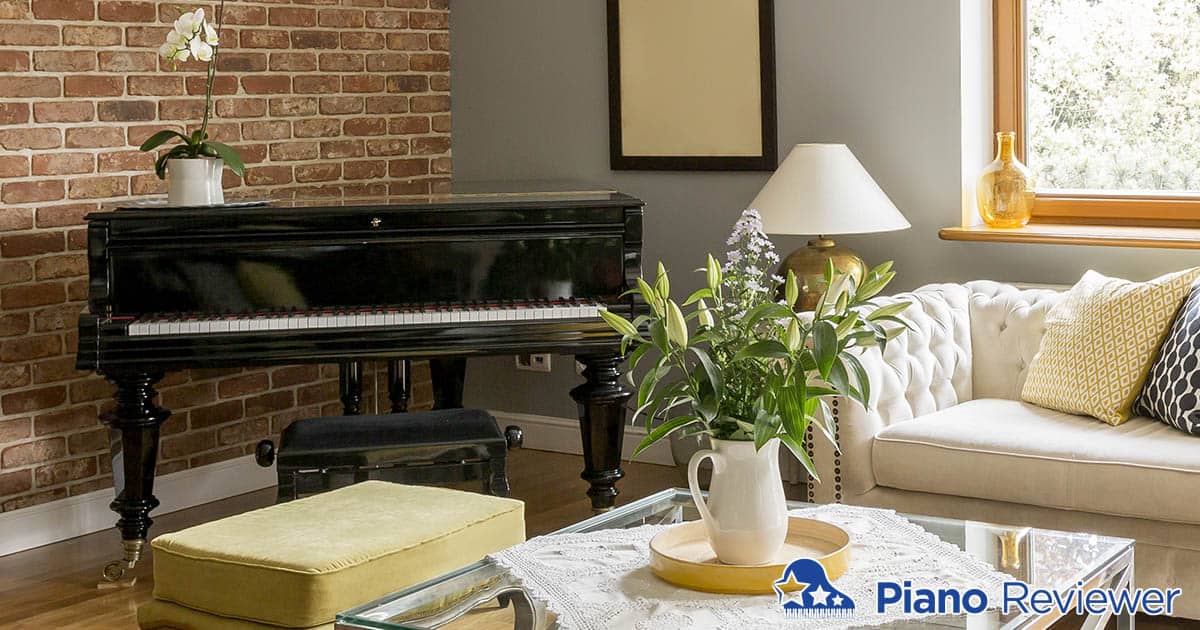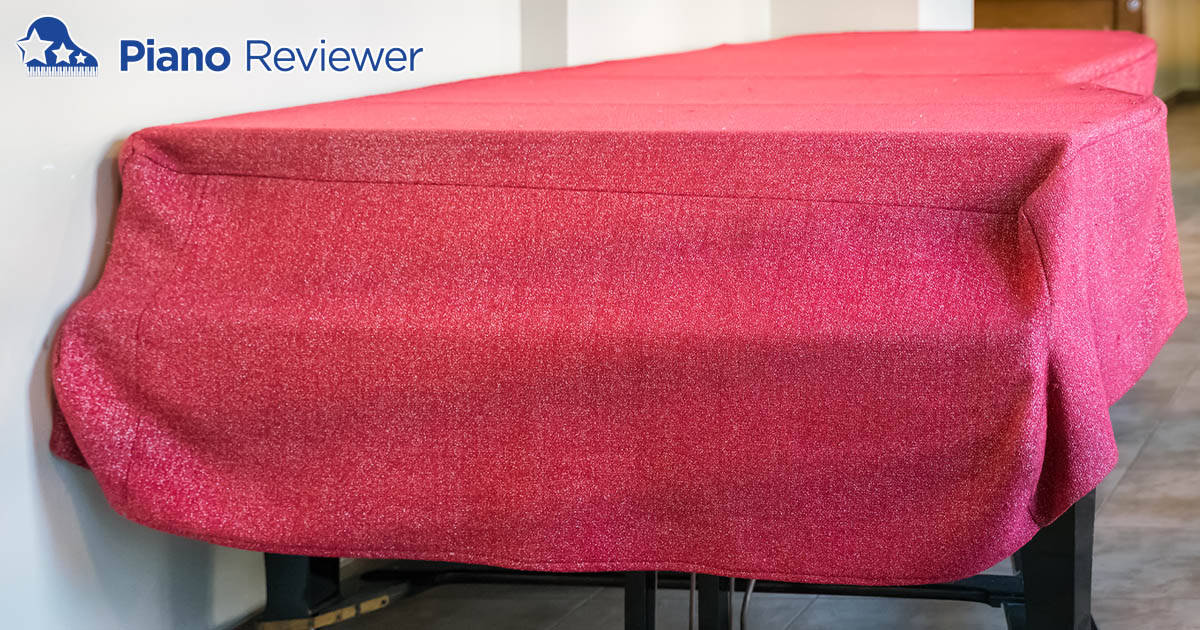You should try to place the instrument against an inner wall, away from direct sunlight, windows, door, and air vents. Finding the perfect spot is important, but if your choices are limited, you can simply invest in a piano cover and a climate control system and pick a place where the instrument won’t cause any discomfort.

Does It Matter Where You Put a Piano?
The piano room placement is going to affect not only how the instrument sounds but also the piano’s lifespan. The aesthetic and look of the instrument are going to largely depend on the placement as well.
Ideally, you would want to consult a piano technician to choose the best place for the instrument together. But it is also possible to find a great location for the piano on your own if you manage to follow the tips mentioned below.
Where to Put Piano in House
Overall, closed-off rooms, formal living rooms, and dining rooms that are separated from the kitchen are the best places for a home piano.
The exact location is going to depend on the type of instrument.
Grand pianos
The straight edge of a grand piano has to be placed against an inner wall, away from air vents and direct sunlight.
You should try to position the instrument so that the pianist is facing the room. Ideally, the bass side of the piano should be running parallel to the wall, but some homeowners choose to place the instrument at a 45-degree angle.
In any case, placing the bass side near the center of the room is not advised. Even though this might help make the instrument quieter, the sound quality won’t be great.
If you have a spacious room, you might consider placing the grand piano right in the center, but only if you have hardwood floors and/or high ceilings.
Tip: you can add special materials to the walls to amplify the sound.
Upright pianos
Just like with grand pianos, upright pianos should be placed away from direct sunlight, doors, and windows.
You would want to put it against an inner wall (try not to position it in a room corner). However, that does not mean that the piano’s back has to be facing the wall; if it’s facing into the room, the sound will be louder, and the pianist will be facing the audience.
It is not recommended to place upright pianos in the center of the room. There should be at least one wall close to the instrument (even if it’s an outer wall) to provide some amount of protection.
Where to Put Piano in Small House
When it comes to small houses, not all the tips mentioned above can be taken into consideration. The main thing that is going to determine the piano placement in such a case is the amount of foot traffic.
In a small room, the family members might end up constantly bumping into the instrument and accidentally scratching it.
Placing the instrument against an inner wall might not be an option, if the room is not wide enough.
If the room has limited space, your comfort should become your top priority. It might be a better decision to put the piano in a ‘bad’ place and invest in a few protective covers than to stop using the room at all.
Where Should You Not Put a Piano?
In direct sunlight
Direct sunlight will make your piano’s finish fade much quicker. High temperatures associated with sun rays will also make the glue joints throughout the instrument weaker and will make the soundboard dry out prematurely.
Even a few hours per day spent in direct sunlight will make your piano look cracked and dried out (in the hotter climates) or moist (in the milder climates).
If sunlight cannot be avoided, you should consider getting a piano cover to protect the instrument during the day.
Next to air vents
Pianos like to be in a stable environment. The less air movement and temperature fluctuations, the better.
That’s why placing the instrument next to air vents, air handlers, or fireplaces is not recommended.
Is It Okay to Put a Piano by a Window?
In your house, the area next to the windows is where the temperature conditions tend to change the most during the day.
Windows can let in the sunlight and cold or hot air. The humidity levels are rarely stable as well.
All these changes will make your piano shrink, swell, and, overall, suffer.
How to Take Care of Your Piano
Don’t worry if you weren’t able to find the perfect place for your piano. There is still one thing that is much more important than the location, and that is care.
Even the instruments that have been put near the window and next to an air vent can end up serving you for decades.
Here are a few things that you might want to consider investing in:
A piano cover
Some covers make your instrument look fancier and more regal. But the main purpose of a piano cover is to protect the instrument from atmospheric changes, kids, and pets, when not in use.

A piano string cover
This extra layer of protection will help make sure that the ‘vocal chords’ of your instrument are free of dust and moisture. A cover made out of 100% woven wool will do a great job at protecting your piano from corrosion and deterioration.
A climate control system
If you are willing to go the extra mile, you can invest in a piano humidity control system that is placed directly into the instrument. The device will maintain the humidity level within the instrument at a constant 42-45% throughout the year.
Of course, the device runs quietly and will not affect the quality of the sound in any way.
A professional climate control system is definitely not an option for everyone. But you can always choose to get UV- and heat-blocking window films, drapes, etc., to manually control the climate in the piano room.
Caster cups
Piano caster cups will make sure that your piano is not rolling around. This helps avoid damaged floors and various injuries.
Caster cups will also protect your floors and carpet from the dents that are usually caused by the piano’s weight throughout the years.
You should remember that a piano is not a shelf. It has to be kept in its original condition (without any photo frames, trophies, or vases).
It might be tempting to use your piano for storage, especially if you have placed it in a small room.
But you should avoid doing that.
Heavy objects will stress the wood and create a rattling noise. Smaller objects can end up ‘traveling’ along the piano due to the vibrations and either scratching the surface or falling over.
Should I Put a Rug Under My Piano?
You can certainly place a rug under the entire footprint of an upright or a grand piano. It will not only visually separate the ‘musical’ part of the room – but a rug will also absorb excess reflected sound.
If a quieter sound is not exactly what you’re going for, then you should leave the floor bare.

Thanks. Lots of good info. I have a Steinway baby grand which I have to tune twice a year because of the New England climate I live in and because I’m a pro. The piano is 100 years old has been treated well but I feel its age in terms of dynamics and key touch. I would love a new piano but time and money make that impractical. Thanks again.